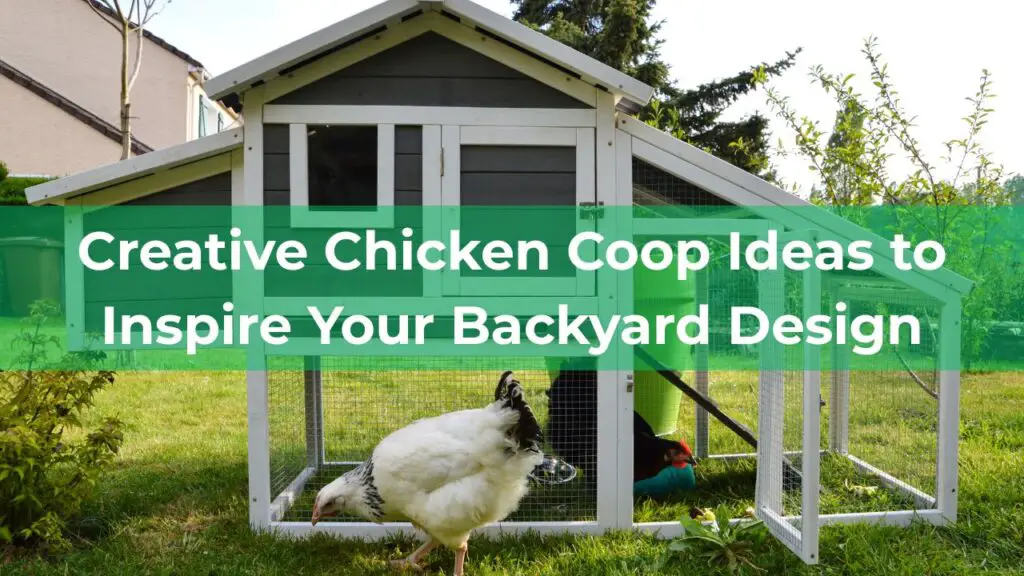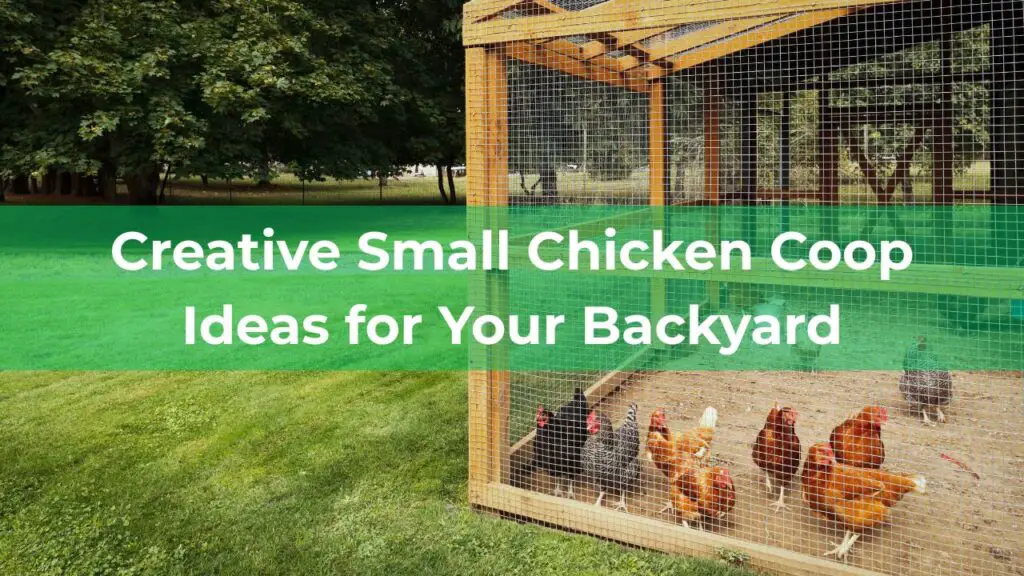Creating your own garden bed can be a fun and rewarding project, allowing you to showcase your creativity while enhancing your outdoor space. From raised beds to vertical planters, there are plenty of DIY designs that suit any skill level and garden style. Dive into some fresh ideas and get inspired to make your garden truly unique!
Metal Container Gardens
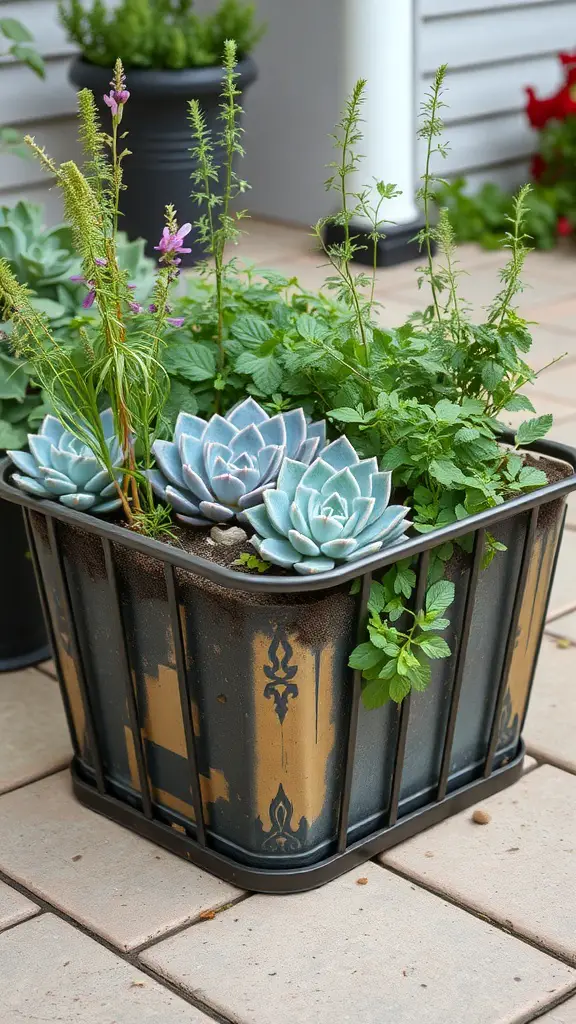
Metal container gardens are a stylish and practical way to grow plants. The image shows a beautifully designed metal container filled with various plants. The container has a rustic look, featuring a mix of colors and textures that add character to any garden space.
In this container, you can see a variety of greenery, including herbs and succulents. The herbs, like mint, are not only useful for cooking but also add a fresh scent to your garden. The succulents bring a unique aesthetic, with their striking shapes and colors.
Using metal containers can be a great choice for those who want to create a modern garden. They are durable and can withstand different weather conditions. Plus, they can be easily moved around, allowing for flexibility in your garden design.
When planning your metal container garden, think about the types of plants you want to include. Mixing herbs with decorative plants can create a vibrant and functional space. Ensure the container has proper drainage to keep your plants healthy.
Vertical Garden Structures
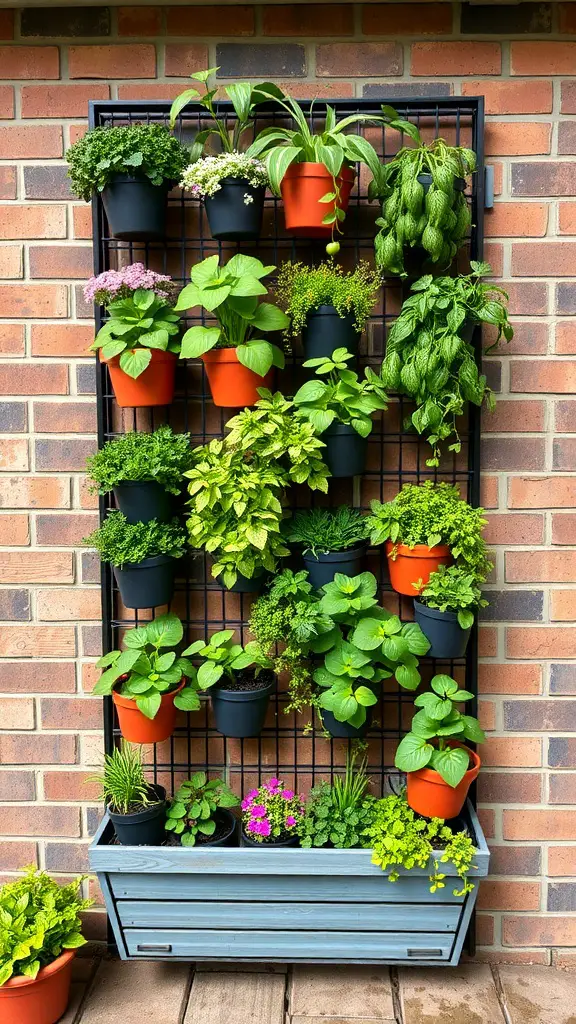
Vertical gardens are a fantastic way to maximize space while adding greenery to your home. The image shows a well-organized vertical garden structure that features various plants in pots arranged on a sturdy frame against a brick wall.
This setup not only saves ground space but also creates a stunning visual display. The combination of different plants, from herbs to flowers, adds texture and color, making it a lively focal point.
Using a vertical garden can be a great solution for small backyards or even balconies. It allows you to grow your favorite plants without needing a large area. Plus, it’s easy to maintain and can be customized to fit your style.
Consider incorporating herbs like basil and mint for cooking, or vibrant flowers to attract pollinators. With a little creativity, you can design a vertical garden that suits your needs and enhances your outdoor or indoor space.
Pallet Garden Beds
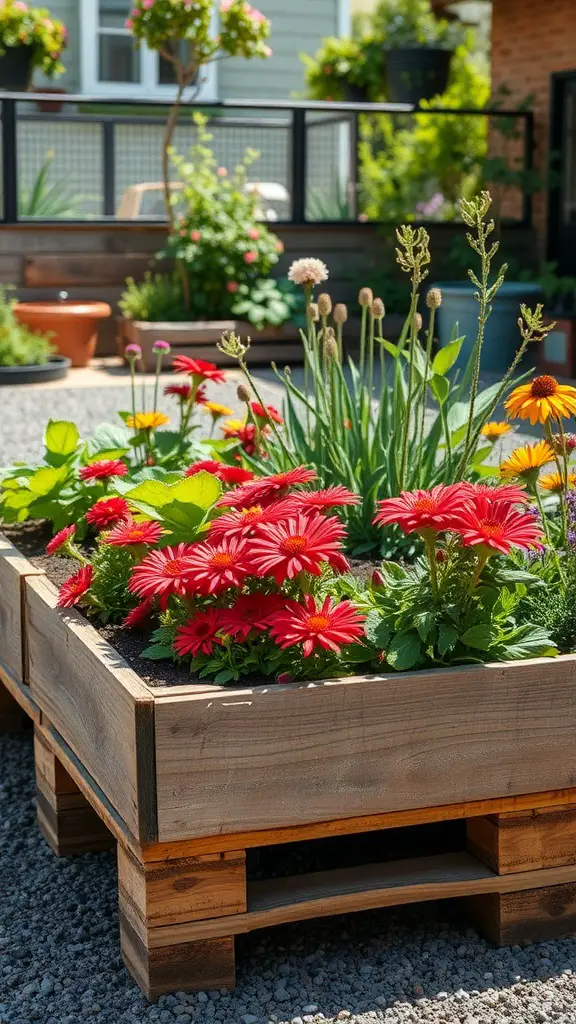
Pallet garden beds are a fun and eco-friendly way to create your own garden space. Using wooden pallets, you can build raised beds that are both stylish and functional. The image shows a beautifully arranged pallet bed filled with vibrant flowers, showcasing how attractive these beds can be.
These beds are easy to assemble and can fit into various garden styles. You can paint or stain the pallets to match your outdoor decor. The raised design makes it easier to tend to your plants, reducing strain on your back and knees.
In the image, the bright red flowers pop against the natural wood, creating a cheerful atmosphere. This setup not only adds beauty to your garden but also encourages biodiversity by attracting pollinators.
Building a pallet garden bed is a great weekend project. Just make sure to use untreated pallets to avoid harmful chemicals. With a little creativity, you can transform any outdoor space into a blooming paradise!
Hugelkultur Garden Beds
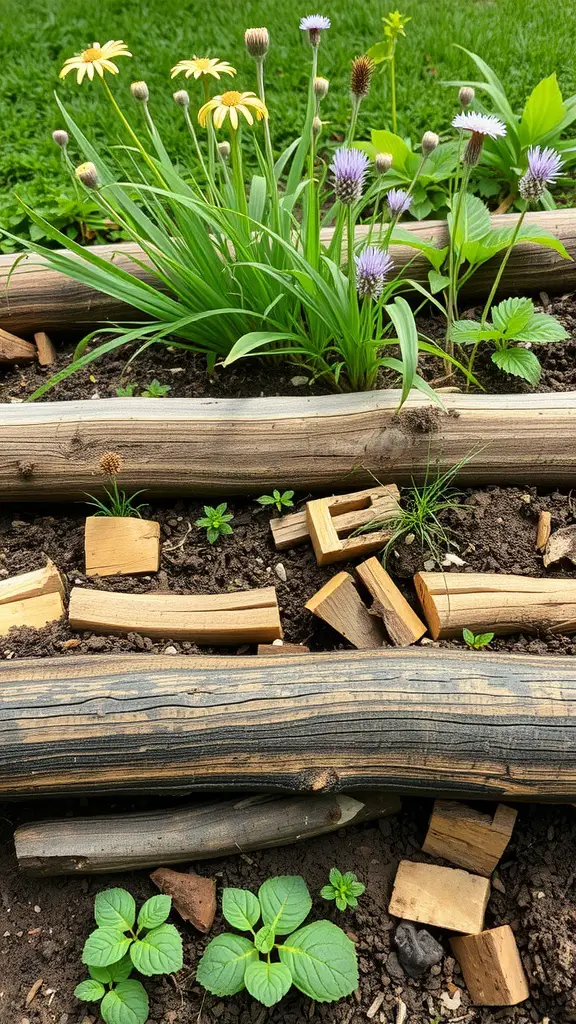
Hugelkultur is a unique gardening method that uses decomposing wood to create raised beds. The image shows a vibrant hugelkultur garden bed filled with various plants and flowers. The logs and branches serve as the base, providing nutrients as they break down over time.
In this setup, you can see colorful flowers like daisies and chives thriving alongside young plants. The combination of wood and soil creates a rich environment for growth. This method not only improves soil quality but also retains moisture, making it easier to care for your plants.
Building a hugelkultur bed is simple. Start by layering logs and branches in a trench. Add smaller sticks and twigs on top, followed by soil and compost. Finally, plant your favorite flowers or vegetables. Over time, the wood will decompose, enriching the soil and supporting healthy plant growth.
Brick Raised Beds
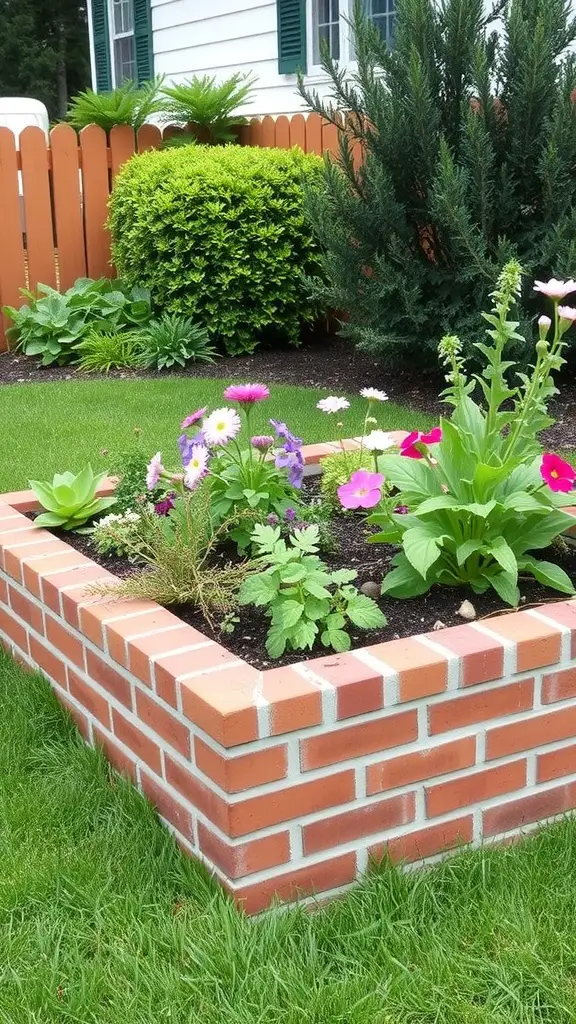
Brick raised beds are a fantastic way to add structure and style to your garden. They not only look great but also provide a sturdy environment for your plants. The image shows a well-defined brick bed filled with colorful flowers, making it a focal point in the yard.
Using bricks allows for excellent drainage and soil retention. This is especially beneficial for plants that thrive in well-drained soil. You can choose from various brick styles and colors to match your garden’s theme.
Creating a brick raised bed is straightforward. Start by selecting a sunny spot in your yard. Lay the bricks in a rectangular or square shape, stacking them to your desired height. Fill the inside with quality soil and compost, then plant your favorite flowers or vegetables.
Not only do these beds enhance your garden’s appearance, but they also make gardening easier on your back. With the plants elevated, you can tend to them without bending over too much. Plus, they can help keep pests at bay!
Tiered Garden Beds
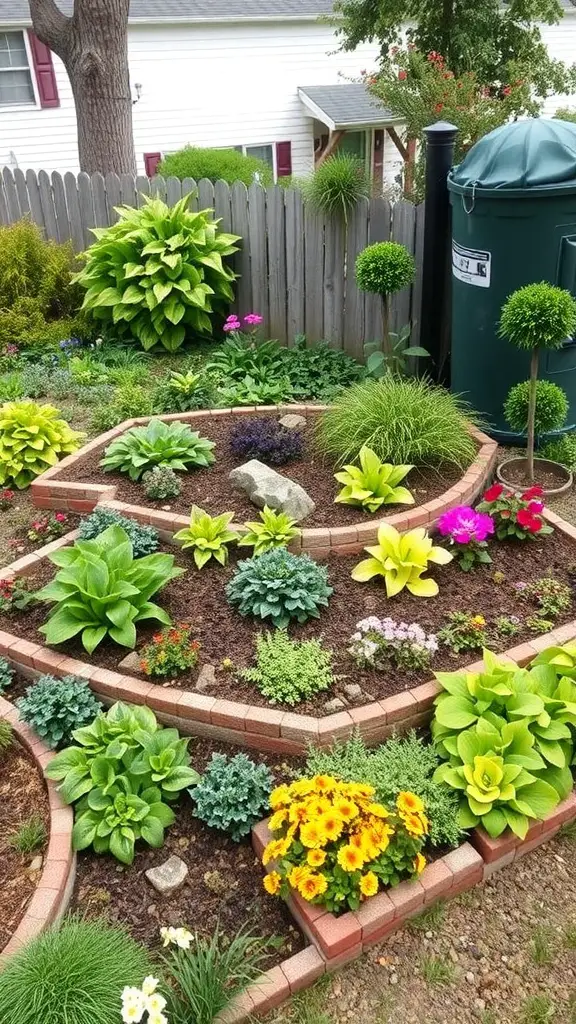
Tiered garden beds are a fantastic way to add depth and interest to your garden. This design allows you to create multiple levels, making it easier to manage plants and flowers. The image shows a beautifully arranged tiered garden, featuring various plants that thrive in different heights.
The layout is not only visually appealing but also practical. Each tier can accommodate different types of plants, from vibrant flowers to lush greens. This diversity enhances the garden’s overall look and promotes healthy growth by allowing for better sunlight exposure and drainage.
In the image, you can see a mix of colorful flowers and leafy plants, all arranged in a way that draws the eye. The use of bricks to define each tier adds a charming touch and keeps everything organized. This setup is perfect for small spaces, as it maximizes the area while creating a stunning focal point.
When planning your own tiered garden bed, think about the types of plants you want to include. Choose a mix of colors and textures to create a lively atmosphere. Don’t forget to consider the sunlight and water needs of each plant to ensure they thrive in their designated spots.
Cinder Block Planters
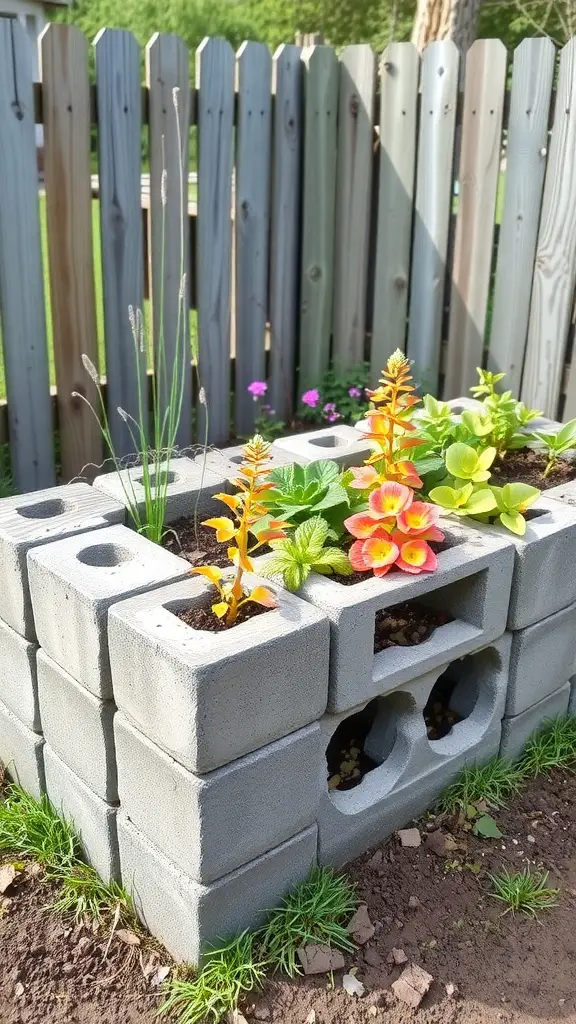
Cinder block planters are a fantastic way to add some charm to your garden. They are not only functional but also offer a unique look that can enhance any outdoor space. The image shows a well-arranged cinder block planter filled with vibrant flowers and herbs. The gray blocks provide a sturdy base while the colorful plants bring life and brightness.
Using cinder blocks for gardening is simple and cost-effective. You can stack them in various configurations to create different shapes and sizes. The hollow spaces in the blocks are perfect for planting herbs or small flowers, making it easy to maintain and water them. Plus, they allow for good drainage, which is essential for healthy plants.
These planters are also great for those who want to try their hand at vertical gardening. You can place blocks on their sides to create a tiered effect, maximizing your planting area. This design is especially useful if you have limited ground space. With a little creativity, you can turn cinder blocks into a stunning focal point in your garden.
Raised Wooden Garden Beds
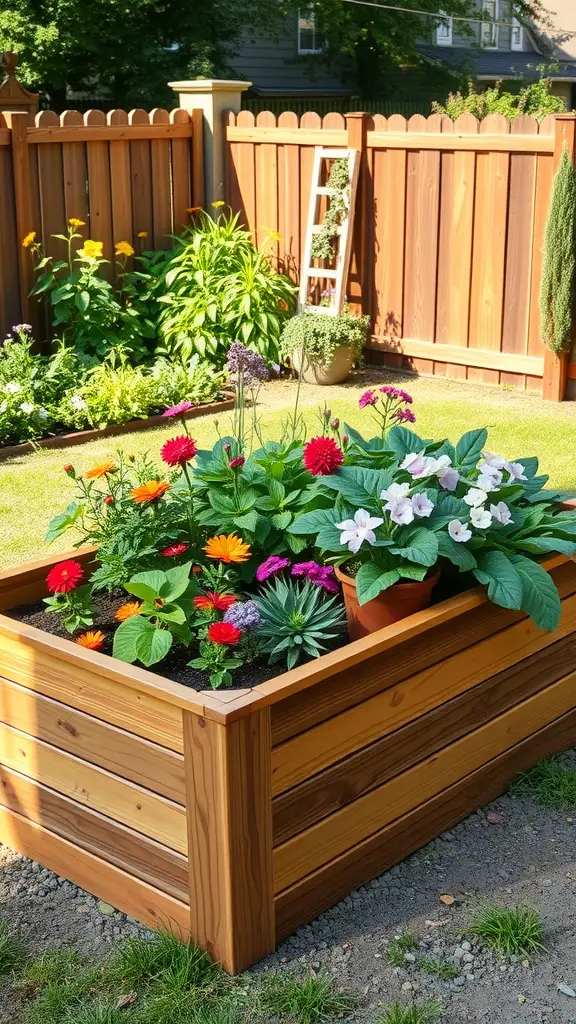
Raised wooden garden beds are a fantastic way to grow flowers and vegetables. They add charm to any garden space while providing a practical solution for planting. The image shows a beautifully constructed wooden bed filled with vibrant flowers, showcasing how inviting these beds can be.
The warm tones of the wood complement the colorful blooms, making the garden feel lively and welcoming. These beds not only look great but also offer benefits like improved drainage and easier access for planting and harvesting.
Building a raised garden bed is straightforward. You can use untreated wood to avoid chemicals leaching into the soil. Simply cut the wood to your desired size, assemble it, and fill it with quality soil. Then, plant your favorite flowers or vegetables, and watch them thrive!
Raised beds are also great for controlling soil quality and keeping pests at bay. Plus, they can be placed anywhere in your yard, allowing for creative layouts. So, if you’re looking to enhance your garden, consider adding a raised wooden garden bed!
Recycled Plastic Garden Beds
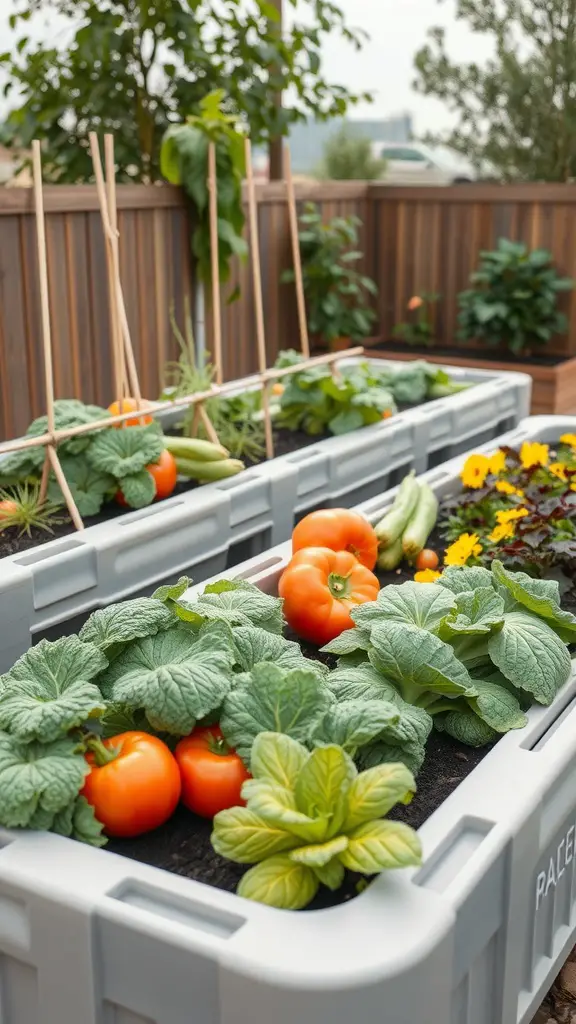
Recycled plastic garden beds are a fantastic way to create a sustainable garden space. These beds are made from repurposed materials, which helps reduce waste and gives a second life to plastic. They are durable and weather-resistant, making them perfect for outdoor use.
The image shows vibrant garden beds filled with healthy vegetables and flowers. You can see lush green leaves, bright orange tomatoes, and even some zucchini peeking out. The design is neat and organized, showcasing how easy it is to maintain a garden using recycled materials.
Using recycled plastic not only benefits the environment but also offers practical advantages. These beds are lightweight, easy to move, and require minimal maintenance. Plus, they can be arranged in various shapes and sizes to fit your garden layout.
If you’re looking to start your own garden, consider using recycled plastic beds. They provide a great way to grow your favorite plants while being eco-friendly. You can enjoy the beauty of your garden and feel good about your choices at the same time.
Hanging Garden Beds
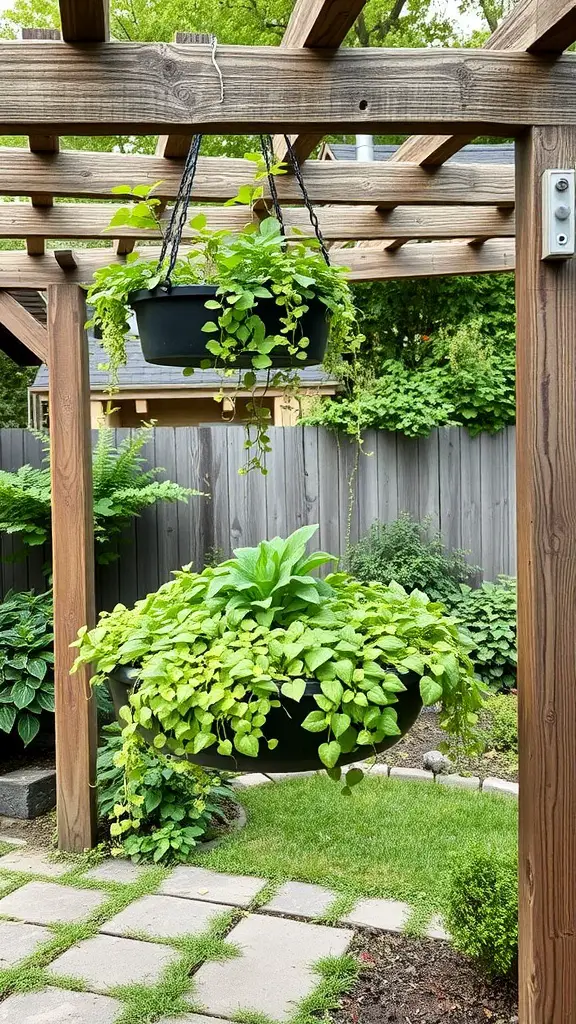
Hanging garden beds are a fantastic way to add greenery to your outdoor space without taking up valuable ground area. They create a lovely visual effect and can be a great conversation starter. In the image, you can see a beautiful setup featuring lush plants in hanging pots.
The plants are thriving, with vibrant green leaves cascading down. This not only looks stunning but also helps to maximize your gardening potential. You can choose a variety of plants, from flowers to herbs, depending on your taste and the sunlight available.
Setting up hanging garden beds is relatively simple. You just need sturdy hooks or a pergola, like the one shown in the image, to support the weight of the pots. Make sure to select pots with drainage holes to keep your plants healthy. Regular watering and occasional fertilizing will keep them flourishing.
Circular Garden Beds
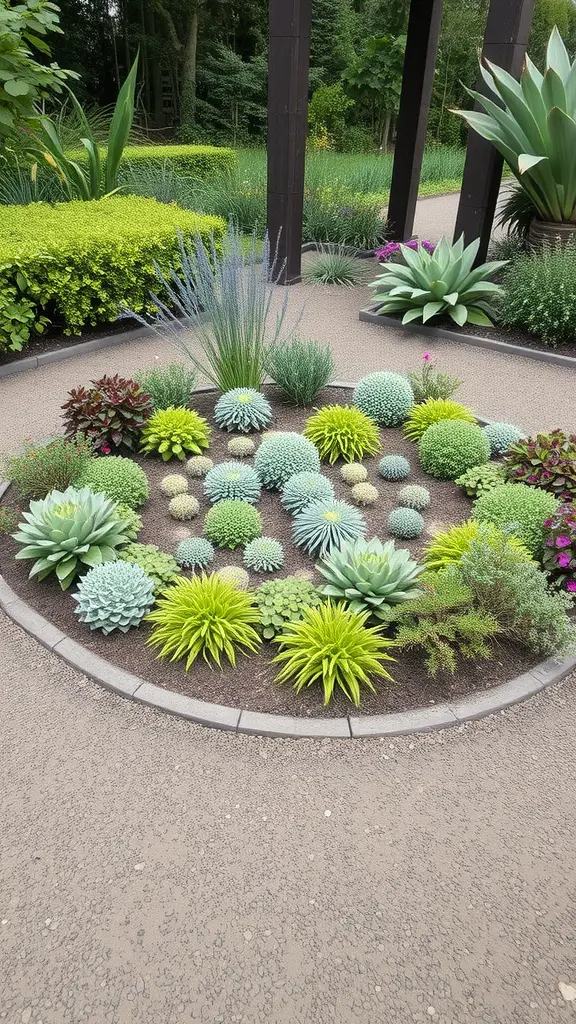
Circular garden beds are a fantastic way to add a unique touch to your outdoor space. They create a focal point that draws the eye and can be designed to fit any style. The image shows a vibrant circular bed filled with a variety of plants, showcasing different textures and colors.
In this design, you can see an array of succulents and other low-maintenance plants. The circular shape allows for easy access from all sides, making it simple to care for your plants. This layout is not only practical but also visually appealing.
When planning your circular garden bed, think about the types of plants you want to include. Mixing different heights and colors can create a stunning display. Consider adding some decorative stones or mulch to enhance the overall look.
Whether you have a small patio or a spacious yard, a circular garden bed can fit right in. It’s a fun project that can bring life to your garden and provide a cozy spot for relaxation.
Concrete Block Raised Beds
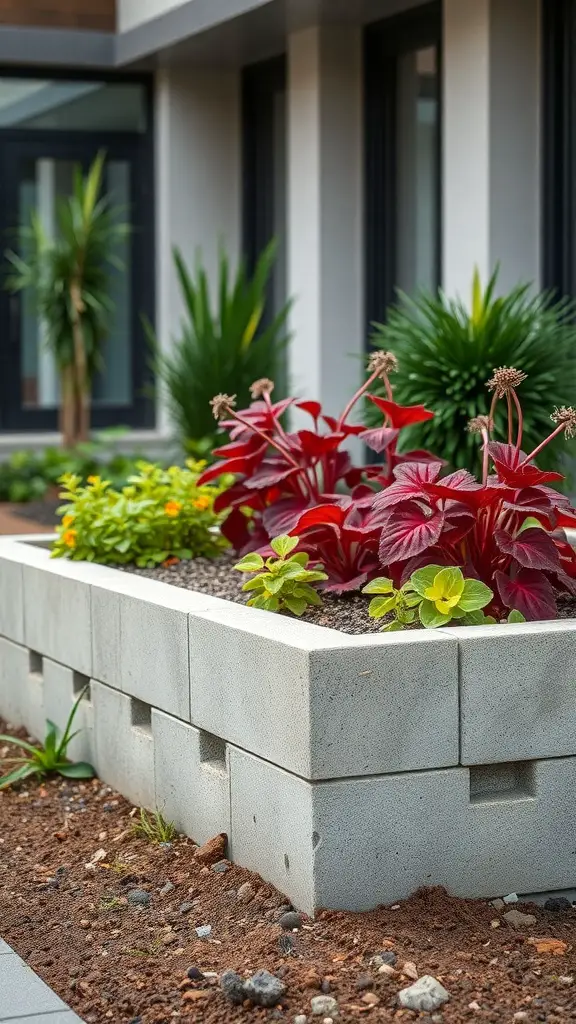
Concrete block raised beds are a fantastic way to create a stylish and functional garden space. They offer a modern look while being durable and easy to maintain. The image shows a beautifully arranged concrete block bed filled with vibrant plants, showcasing how these beds can enhance any garden.
Using concrete blocks allows for flexibility in design. You can stack them in various configurations to fit your space. The blocks also provide excellent drainage, which is essential for healthy plant growth. Plus, they can be painted or left in their natural state to match your garden’s aesthetic.
In the image, you can see colorful plants thriving in the raised bed. This not only adds beauty but also makes gardening easier on your back. Raised beds reduce the need to bend down, making it more comfortable to tend to your plants. If you’re looking to add a touch of creativity to your garden, concrete block raised beds are a great option!
DIY Straw Bale Garden Beds
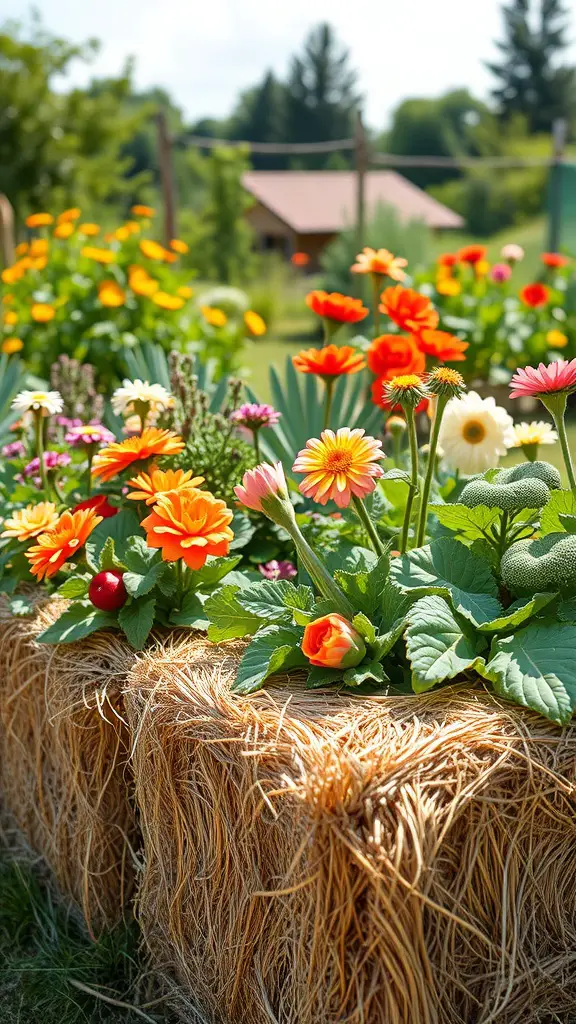
Straw bale gardening is a fun and creative way to grow plants without traditional soil beds. The image shows vibrant flowers blooming in a straw bale garden. The colorful blossoms, including orange and pink flowers, create a lively scene.
Using straw bales as garden beds offers several benefits. They provide excellent drainage and warmth for plants. As the bales break down, they also add nutrients to the soil. This method is perfect for those with limited space or poor soil quality.
To start your own straw bale garden, choose a sunny spot and arrange the bales in your desired layout. Water the bales thoroughly for a few days to begin the decomposition process. After that, you can plant directly into the bales. Consider using flowers, herbs, or even vegetables to create a beautiful and productive garden.
Garden Bed Borders
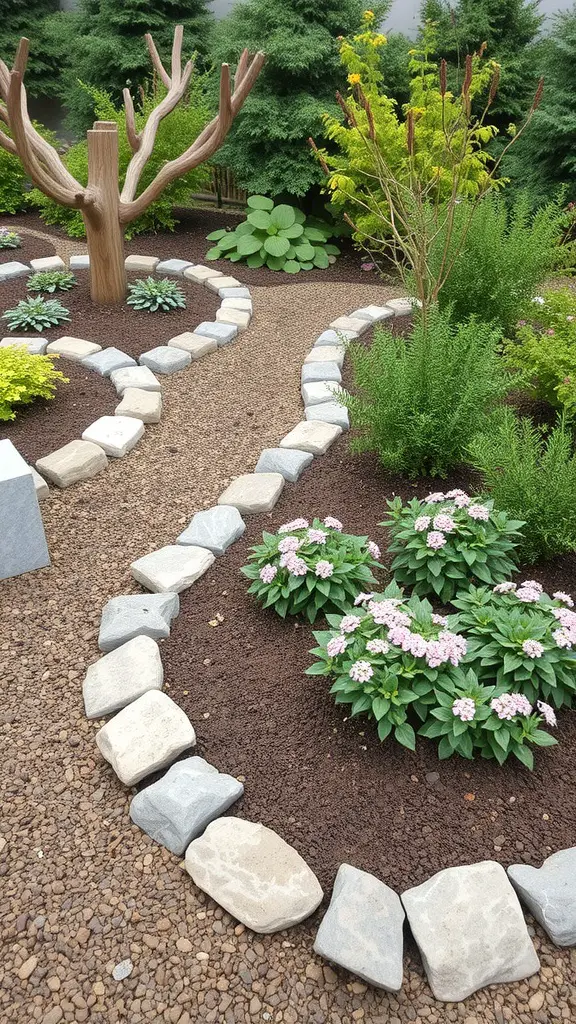
Garden bed borders can really make your outdoor space pop. In the image, you can see a lovely arrangement where stones create a clear boundary around the flower beds. This not only defines the space but also adds a touch of style.
The use of different colored stones gives a nice contrast to the greenery and flowers. The soft curves of the border lead the eye around the garden, making it feel inviting. It’s a simple yet effective way to enhance the overall look of your garden.
Incorporating natural elements like stones or wood can blend beautifully with plants. The tree in the center adds a focal point, drawing attention and creating a cozy atmosphere. This design encourages creativity, allowing you to choose materials that match your personal style.
Sunken Garden Beds
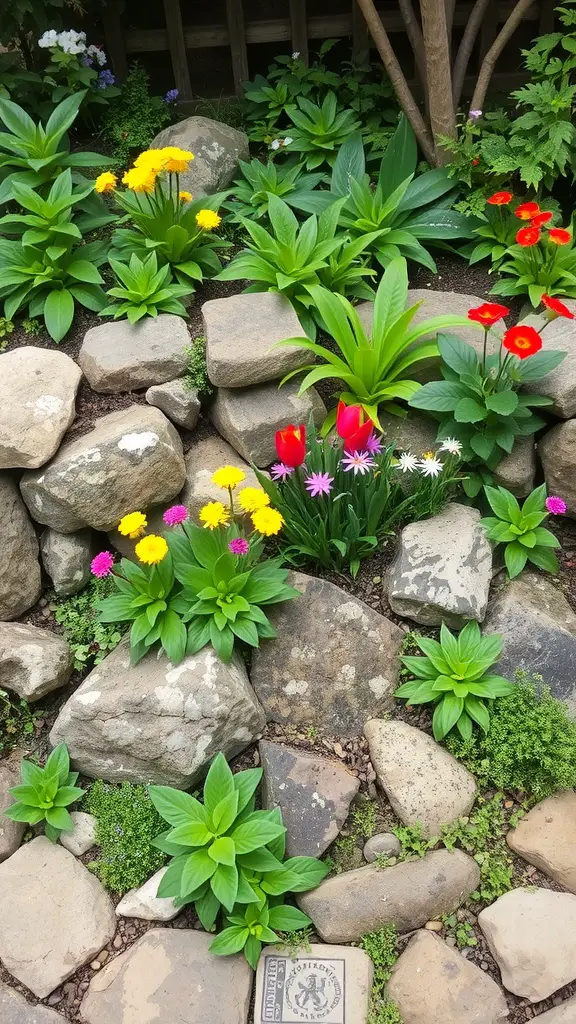
Sunken garden beds are a fantastic way to add depth and interest to your garden. These beds are set below ground level, creating a cozy nook for plants to thrive. The image shows a beautiful example of a sunken garden bed filled with vibrant flowers and lush greenery.
The rocks surrounding the plants not only provide a natural look but also help with drainage. This is key for keeping your plants healthy. The mix of colors, from bright yellows to deep reds, creates a cheerful atmosphere. You can see how the flowers pop against the backdrop of rich green leaves.
Creating a sunken garden bed is simple. Start by digging a hole in your desired location. Make sure to remove any weeds or grass. Then, line the edges with stones or bricks for a clean finish. Fill the bed with quality soil and choose your favorite plants. This design not only looks great but also makes gardening easier, as the lower height reduces bending and stretching.
Herb Spiral Garden
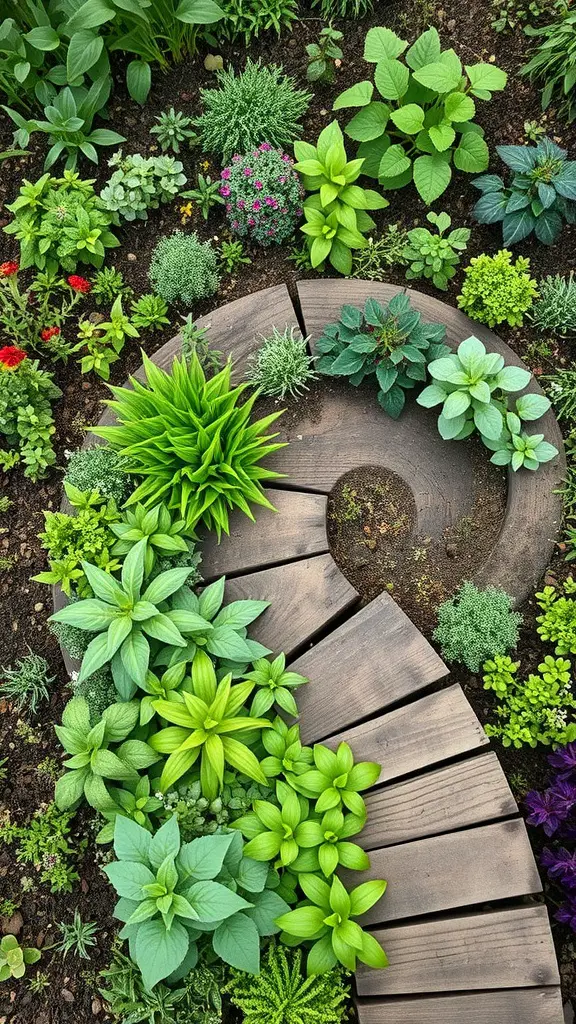
A herb spiral garden is a fantastic way to grow a variety of herbs in a small space. This design features a spiral shape that allows for different microclimates, making it perfect for various plants. The image shows a beautifully arranged herb spiral, with vibrant greens and pops of color from the flowers.
The spiral design not only looks appealing but also maximizes space. Herbs like basil, mint, and thyme thrive in this setup. The higher sections of the spiral get more sunlight, while the lower areas retain moisture, benefiting herbs that prefer different conditions.
Building a herb spiral is straightforward. Start with a sturdy base, like stones or wood, and create a spiral shape. Fill it with quality soil and plant your herbs according to their sunlight and water needs. This method is not just practical; it also adds a unique touch to your garden.
Wooden Crate Planters
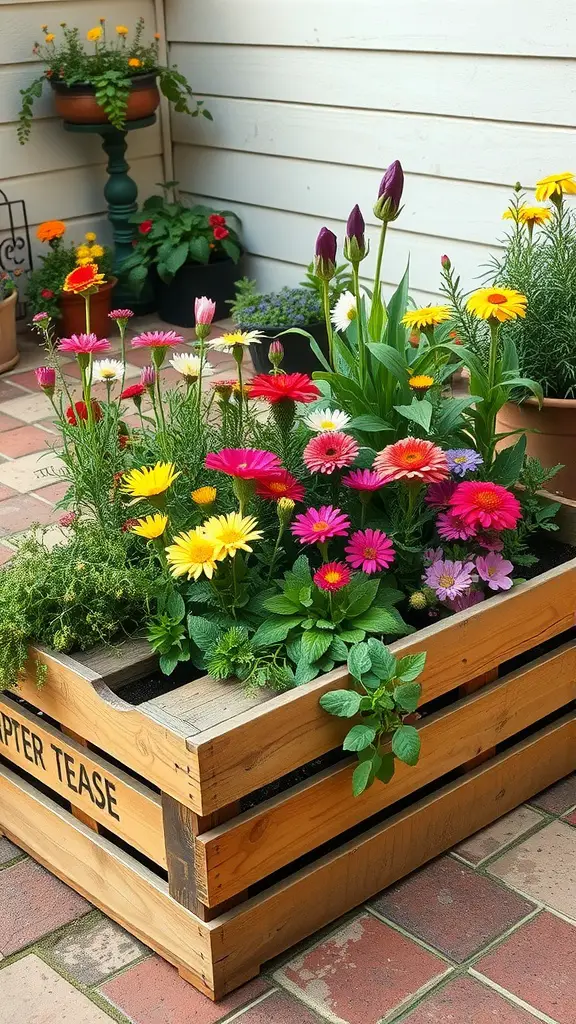
Wooden crate planters are a charming way to add character to your garden. They are not only functional but also bring a rustic touch to any outdoor space. You can easily find or repurpose old wooden crates, making this a budget-friendly option.
In the image, you see a vibrant display of flowers in a wooden crate planter. The colorful blooms create a lively atmosphere, showcasing how these planters can brighten up any corner of your garden. The mix of flowers adds texture and visual interest, making it a delightful focal point.
To create your own wooden crate planter, start by selecting a sturdy crate. Line the bottom with landscaping fabric to allow for drainage while keeping the soil in place. Fill it with potting soil and choose your favorite plants. You can mix herbs, flowers, or even small vegetables for a diverse garden bed.
Position your crate in a sunny spot, and watch your plants thrive. Wooden crate planters are not just pretty; they also make gardening accessible, especially for those with limited space. Enjoy the process of planting and caring for your garden, and let your creativity shine!
Garden Bed with Trellis
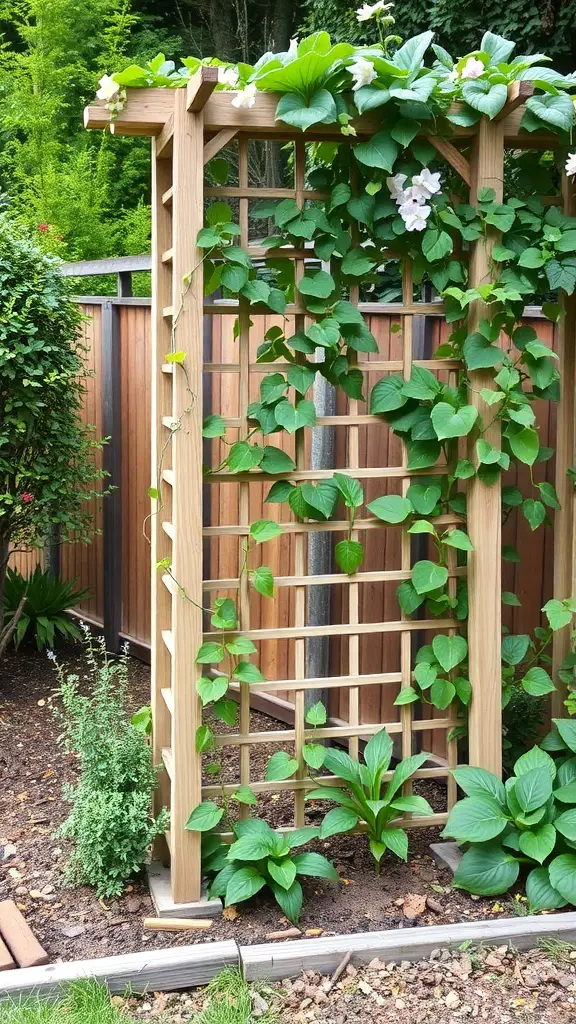
A garden bed with a trellis adds charm and functionality to any outdoor space. The trellis serves as a support for climbing plants, allowing them to grow vertically. This not only saves space but also creates a beautiful display of greenery and flowers.
In the image, you can see a well-constructed wooden trellis adorned with lush green vines and delicate flowers. The natural wood complements the surrounding plants, making it a lovely focal point in the garden. The trellis not only enhances the aesthetic but also provides a habitat for beneficial insects.
When planning your garden bed, consider incorporating a trellis. It can be a great way to grow vegetables like cucumbers or beans, which thrive when given vertical space. Plus, the added height can create a sense of privacy or separation in your garden.
Overall, a garden bed with a trellis is a simple yet effective way to elevate your gardening experience. It encourages creativity and allows you to enjoy the beauty of nature in a more organized manner.
Garden Bed with Pathways
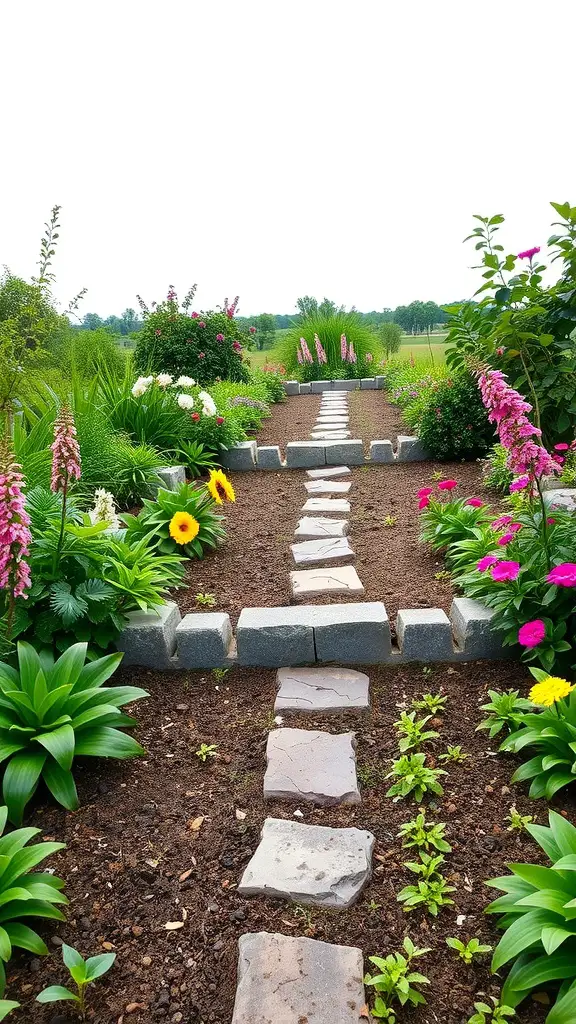
Creating a garden bed with pathways is a fantastic way to enhance your outdoor space. The image shows a lovely layout where stepping stones guide you through vibrant flowers and lush greenery. This design not only looks great but also makes it easier to navigate your garden.
The pathways break up the garden bed, allowing for easy access to plants. You can tend to your flowers without stepping on the soil, which helps keep everything healthy. The stones used for the path add a rustic charm, blending beautifully with the natural surroundings.
Incorporating pathways can also help define different areas of your garden. You might choose to plant herbs on one side and colorful blooms on the other. This way, your garden becomes a delightful mix of textures and colors, making it a joy to explore.
Wooden Frame Garden Beds
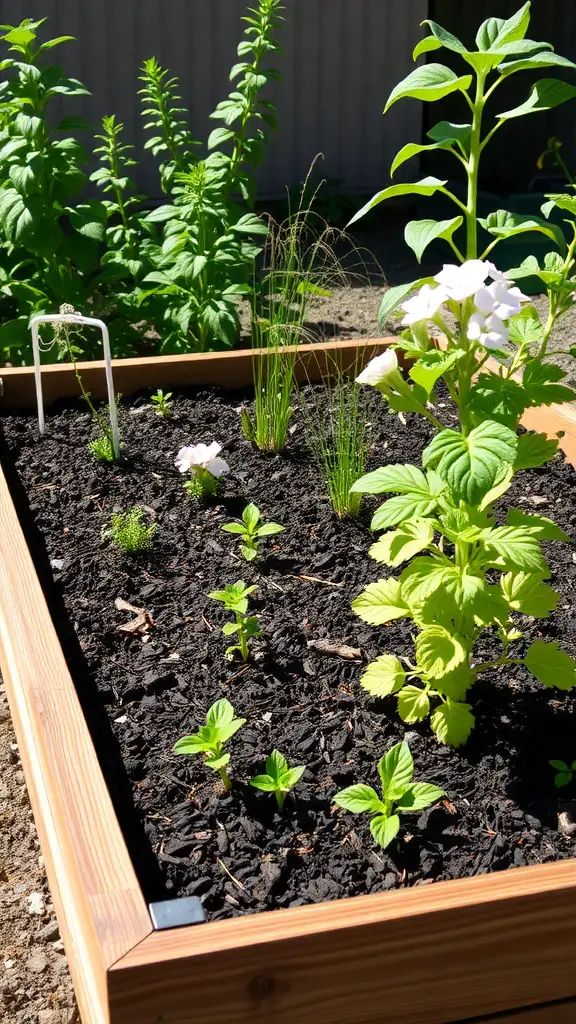
Wooden frame garden beds are a fantastic way to start your gardening journey. They provide a neat and organized space for your plants, making it easier to manage and maintain your garden.
The image shows a beautifully constructed wooden frame filled with rich soil and a variety of plants. You can see vibrant flowers and fresh herbs peeking out, showcasing the potential of a well-planned garden bed.
Using wood for your garden frames not only looks great, but it also helps with drainage and soil temperature. The natural materials blend seamlessly into any outdoor space, adding a rustic charm.
When building your own wooden frame garden bed, consider the size and location. A raised bed can be a perfect choice for those with limited space or poor soil conditions. Plus, it keeps your plants safe from pests and makes weeding a breeze!
Overall, wooden frame garden beds are a practical and attractive option for anyone looking to grow their own plants. They invite creativity and can be tailored to fit your gardening style.
Natural Stone Garden Beds
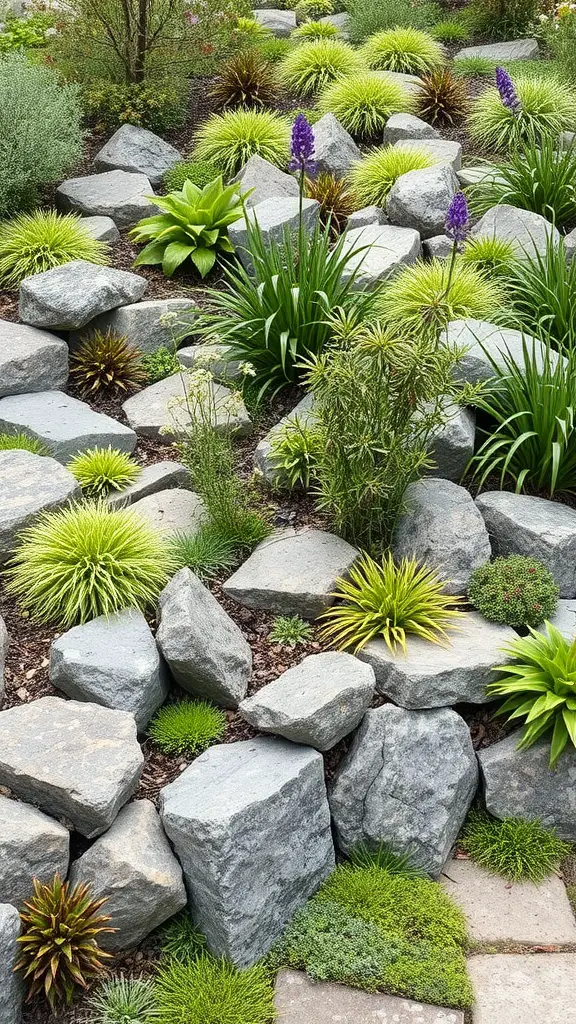
Natural stone garden beds bring a rustic charm to any outdoor space. The image shows a beautiful arrangement of large, flat stones interspersed with vibrant green plants and colorful flowers. This design not only looks appealing but also provides a sturdy structure for your garden.
Using stones in your garden beds can create a natural look that blends seamlessly with the environment. The varying shapes and sizes of the stones add texture and interest. Plus, they help with drainage, ensuring your plants stay healthy.
When planning your stone garden bed, think about the types of plants you want to include. Low-growing plants and colorful blooms work well with the stone layout. The contrast between the hard stones and soft foliage creates a lovely visual balance.
Building a natural stone garden bed is a fun DIY project. Start by selecting your stones and arranging them in a way that suits your space. Fill in the gaps with soil and your chosen plants. This hands-on approach can be rewarding and gives you a unique garden feature.
Compost Bin Garden Beds
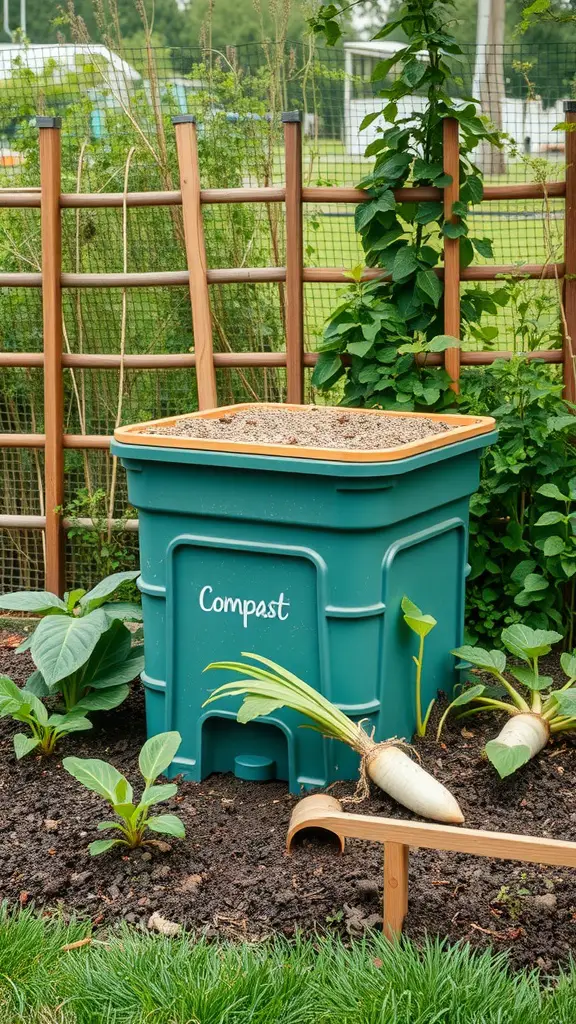
Compost bin garden beds are a fantastic way to combine gardening with sustainability. The image shows a vibrant compost bin surrounded by healthy plants. This setup not only looks great but also serves a practical purpose.
The compost bin, labeled ‘Compost’, is designed to hold organic waste that will break down into nutrient-rich soil. This process enriches the garden bed, providing essential nutrients for the plants nearby. You can see various plants thriving around the bin, showcasing the benefits of using compost.
Using a compost bin in your garden bed design is simple. Start by placing the bin in a sunny spot, as warmth helps the compost break down faster. Add kitchen scraps, yard waste, and other organic materials to the bin. Over time, this will create a rich compost that you can use to nourish your plants.
Incorporating a compost bin into your garden bed design not only helps in waste reduction but also promotes a healthier garden. It’s a win-win situation for both your plants and the environment!
Wildflower Garden Beds
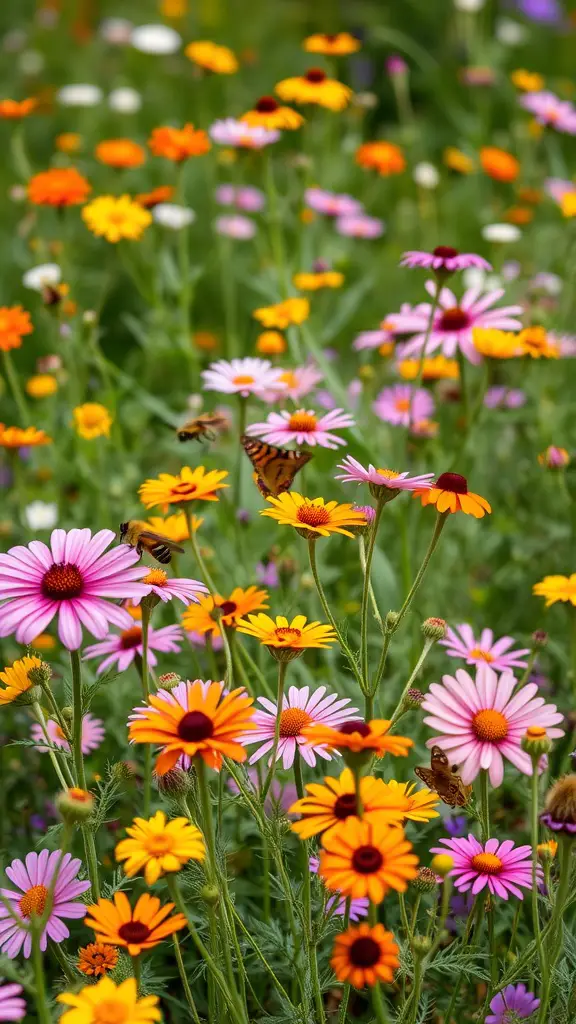
Wildflower garden beds are a fantastic way to bring color and life to your outdoor space. Imagine stepping into a vibrant patch filled with daisies, marigolds, and other cheerful blooms. This image captures the essence of such a garden, showcasing a delightful mix of flowers in shades of pink, orange, and yellow.
Creating a wildflower garden is not just about aesthetics; it also supports local wildlife. Bees and butterflies are drawn to these flowers, making your garden a buzzing hub of activity. These pollinators play a crucial role in our ecosystem, and your garden can help provide them with the food they need.
When planning your wildflower bed, consider using native plants. They are well-suited to your local climate and soil, requiring less maintenance. Plus, they attract the right insects and birds to keep your garden thriving. You can easily create a stunning display by mixing different flower types and heights.
To get started, choose a sunny spot in your yard. Prepare the soil by removing weeds and rocks, then scatter your wildflower seeds. Water them gently and watch as your garden transforms into a colorful paradise. With a little patience, you’ll have a beautiful wildflower bed that brings joy to your home.
Portable Garden Beds
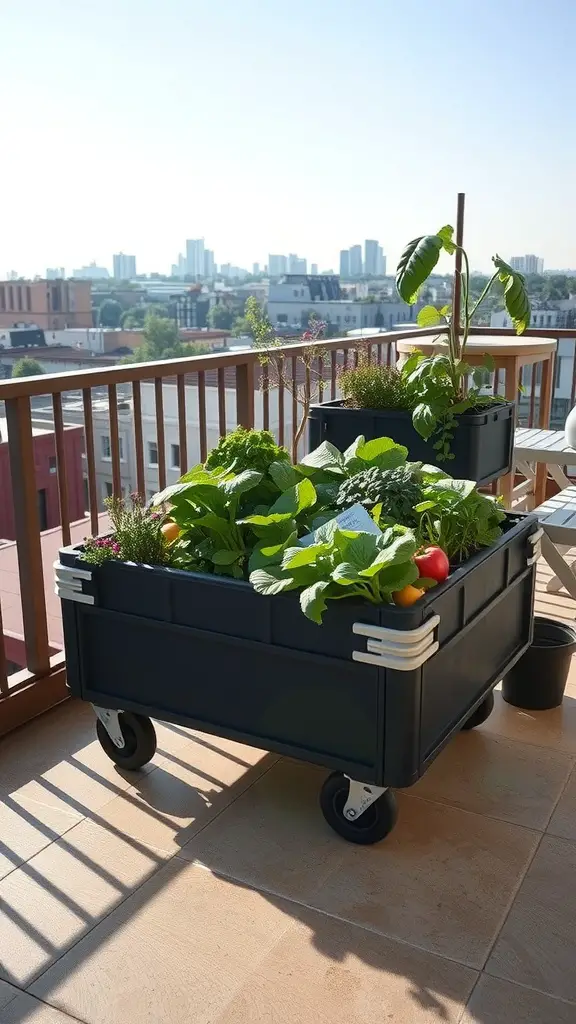
Portable garden beds are a fantastic option for those who want to grow their own plants without being tied down to a specific spot. The image shows a stylish, wheeled garden bed filled with vibrant greens and colorful vegetables. This setup is perfect for small spaces, like balconies or patios, where traditional gardening might not be feasible.
The mobility of these beds allows you to move them around to catch the best sunlight or to rearrange your outdoor space. You can easily roll them to a sunny spot in the morning and then back to a shaded area in the afternoon. This flexibility is especially helpful for delicate plants that may need different light conditions throughout the day.
Using a portable garden bed also makes it easier to manage your plants. You can reach them without bending down too much, which is great for those with back issues. Plus, they can be filled with high-quality soil, ensuring your plants get the nutrients they need to thrive.
Whether you’re growing herbs, vegetables, or flowers, a portable garden bed can add beauty and functionality to your outdoor space. They are a simple solution for anyone looking to enjoy gardening without the commitment of a permanent garden bed.

